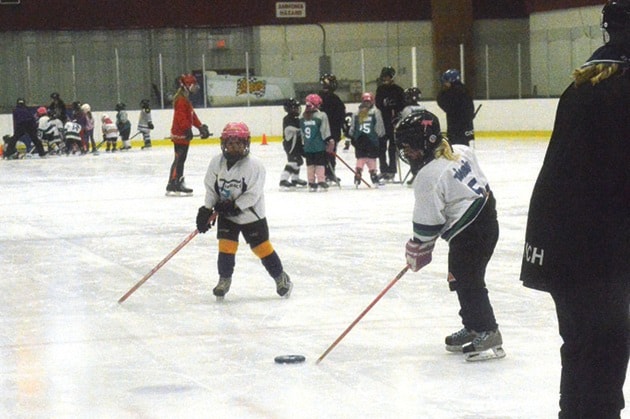The Terrace Ringette Association continues to grow, making ice time for players over the age of 18 and by creating a division for the youngest age group.
The new U7 team, as well as the U9 team, have nearly doubled in the number of boys playing the sport, traditionally regarded as one for girls only.
“Lots of times in prior years, [the boys] stick around only one year,” said club president Peggy Pavao. “Now more are staying longer than just learning to skate.”
This year nearly half of the U7 and U9 players are boys, instead of the usual small handful of four- year-old boys there just to learn how to skate.
Ringette was invented as a winter sport for girls in 1963. It was developed in Ontario and is now growing as a co-ed sport both nationally and internationally.
Here in Terrace the club started just over 25 years ago, in 1989. The Wilkinson and Myers families had children to form half a team and recruited a few friends to join them to play.
Since then the club has been growing every year, with 70 children this year, 61 last year and 50 the year before. The number of children under age nine has doubled and is the main source of growth.
Coaches say it’s the team dynamics of ringette and simple word of mouth that is multiplying the interest in the sport, and they love working with the little players.
“Coaching these kids has been an incredible rewarding experience,” said Dinah Qualizza, the U7 and U9 coach.
“It gives me incredible satisfaction to watch these little guys go from crawling on the ice to now outskating me,” she said.
She delights in the many brother and sister teammates, watching them support each other as they learn. She said that some families have four siblings involved in the sport.
“This is how the sport keeps growing, younger siblings watch their brother or sister on the ice and want to come out,” Qualizza said. “Then word gets out to friends and relatives and they want to join too!”
 Qualizza admits there are periods when she may not feel like going out to the rink but finds that when she does, it is always rewarding in the end.
Qualizza admits there are periods when she may not feel like going out to the rink but finds that when she does, it is always rewarding in the end.
“I find the energy and go, and I come off the ice after an hour and have a big smile on my face and feel rejuvenated! The smiles on the kids faces are all I need to know that they had fun and hopefully learned some new skills,” she said.
Qualizza no longer has children in the sport, but stays to coach partly for love of the game.
Though ringette has a similar set up to hockey, with teams of six players aiming to put the ring in the back of the opponents’ net, the sport has a completely different dynamic.
Players cannot check each other at all and have to work more tightly as a team, with rules requiring them to make a pass every time they cross a blue line.
“It’s a real team sport,” said Pavao. “Players have to pass, so more players are involved in [every play]. They are always looking up for [a team mate they can pass to].”
Ringette also has a larger and more strict goalie crease, which no other player can enter, and goalies grab the rings by hand and toss them to players in a quick five seconds.
Only three forward players are allowed past a certain line to make offensive attacks, club president Pavao added, which forces players to spread out and avoids congestion.
Ringette adds another dynamic in the higher levels when a shot clock is introduced, similar to basketball, which forces teams to move quickly and shoot within the first 30 seconds of getting possession of the ring.
“It’s a real team sport,” Pavao said as one of the reasons for its allure. It’s also great for families, she added, explaining that games are co-ed and tournaments include all ages.
Jacque Wilkinson, club past president, said her fondness for the game flows from the joy of watching the children.
She loves “watching how they work as a team, how they support each other and best of all the big smiles when they score a goal. I watch these 4-8 year olds grow into great little people... It’s not all about winning, it’s about having fun, teamwork and getting a chance to score that goal.”
